Underground Mine Fires: Understanding the Dangers and Response Procedures

Introduction
Mine fires are a serious hazard in the mining industry, posing a significant threat to the safety of miners and the overall stability of underground operations. These fires can originate from various sources, including frictional heat, electrical sparks, spontaneous combustion, and the improper handling of flammable materials.
The Dangers of Underground Mine Fires
The dangers associated with underground mine fires are multifaceted, often leading to devastating consequences. These fires can produce toxic gases, such as carbon monoxide and hydrogen sulphide, which can cause respiratory failure and even death. In addition, , the intense heat generated by these fires can lead to the collapse of mine structures, trapping miners and hindering rescue efforts.
Factors Contributing to Underground Mine Fires
Several factors contribute to the occurrence of underground mine fires, including:
- Ventilation issues: Poor ventilation systems can lead to the accumulation of combustible gases, increasing the risk of fire ignition.
- Frictional heat: The friction generated by machinery and equipment can ignite combustible materials, particularly in areas with limited airflow.
- Electrical faults: Electrical faults and sparks can ignite nearby flammable materials.
- Spontaneous combustion: Self-heating of certain materials, such as coal or pyrite, can lead to spontaneous combustion without an external ignition source.
- Improper handling of flammable materials: Careless handling or storage of flammable materials, such as fuels and lubricants, can increase the risk of fire.
Detecting and Responding to Underground Mine Fires
Early detection of an underground mine fire is crucial for minimising its impact and facilitating an effective response. Mine fire detection systems employ various methods, including smoke detectors, temperature sensors, and gas monitoring devices. Once a fire is detected, a rapid response is essential to prevent the spread of the fire and ensure the safety of miners. The FRONTLINE® early warning emergency evacuation system is a revolutionary system that we have developed to provide miners with early warning in event of a fire.
Emergency Response Procedures
Emergency response procedures for underground mine fires involve several key steps:
- Evacuation: The primary objective is to evacuate all miners from the affected area and the mine as a whole, either to a refuge bay or to surface. Escape routes and refuge bays are critical components of emergency response plans.
- Fire suppression: Automatic fire suppression systems linked to gas detectors is crucial to ensure quick fire surpression. Firefighting teams are deployed to extinguish the fire, utilising water mist systems, foam, or inert gas depending on the fire’s nature.
- Ventilation control: Adjusting ventilation systems can help control the spread of smoke and gases, directing them away from evacuation routes and firefighting personnel.
- Communication and monitoring: Maintaining clear communication channels between emergency response teams, miners, and surface personnel is essential for coordinating evacuation efforts and monitoring the situation closely.
Prevention Strategies
Preventing underground mine fires requires a comprehensive approach that addresses potential hazards and promotes safe practices. Effective prevention strategies include:
- Ventilation system maintenance: Regular maintenance of ventilation systems ensures adequate airflow and prevents the accumulation of combustible gases.
- Equipment inspection and maintenance: Regular inspection and maintenance of machinery and electrical equipment can identify and rectify potential sources of ignition.
- Training and education: Providing miners with thorough training on fire prevention procedures and emergency preparedness and response protocols can enhance overall safety.
- Strict handling procedures: Enforcing strict handling and storage procedures for flammable materials can minimise the risk of accidental ignition.
- Fire suppression systems: Installing fixed fire suppression systems in high-risk areas can provide an additional layer of protection.
Conclusion
Underground mine fires pose a significant threat to the safety of miners and the stability of mining operations. Early detection, rapid response, and effective prevention strategies are crucial for mitigating the impact of these fires and protecting the lives of those who work underground. By prioritising safety, mining companies can create a safer working environment and minimise the risk of these devastating incidents. Rescue One’s Lifeline® directional rope system can guide miners to safey in zero visibility, whilst the Frontline® system can provide early warning and support miners to escape in visible conditions.
Speak to us at Rescue One Equipment about our mine safety systems and how we can aid you in ramping up the safety in your mines.